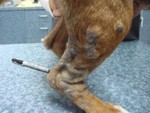|
Canine Lick Granuloma
Lick Granulomas - skin lesions created by licking

Lick Granulomas are skin wounds that the dog creates from excessive licking. The licking can be caused by many factors as discussed below.
1. Behavior
2. Infection/Inflammation
- Hair follicle infection
- Secondary skin infection
- Allergies
3. Joint Pain
Because there are multiple possible causes, there are also multiple ways to treat this condition. No one treatment is curative or correct for every dog. Response usually involves using the correct selection of treatments for the specific individual.
Some treatments currently used include
1. Calming/anti-depressant medication
- Clomipramine – is widely used for various canine anxiety disorders and is generally considered one of the safest of these types of medications. However, with all medications regular blood work should be done to monitor organ status.
2. Antibiotics:
- Often these are needed for a long course of treatment (6+ weeks).
- These are generally needed for secondary skin infection created by licking.
3. Protection of wound from licking:
This is one of the most important aspects of treatment and often the most frustrating for the owners Elizabethan collars- commonly used to keep the patient from having access to the wound. Bite-Not collars – (think of a whip-lash type neck collar) Bandaging – is often used but only successful if the patient doesn’t remove the bandage.
4. Steroids and Non-steroidal anti-inflammatory drugs (NSAID):
Steroids are potent reduces of inflammation and they help relieve itchy skin. Many different kinds of steroids are commonly used. These are all used on a limited basis due to the many potential side-effects they can produce with long term use. The steroids commonly used in veterinarian medicine are glucocorticoids and not anabolic steroids (the type misused by some athletes). Common names include cortisone, cortisol, and hydrocortisone.
Steroids
- Prednisone – an oral pill or an injections, also often used in topical products
- Temeril P – pill with low dose prednisone + antihistamine + cough suppressant
- Methylprednisolone – pill or injection
- Triamcinolone – injection only, long lasting
- Dexamethasone – Both Azium and SP – injections
- Hydrocortisone – commonly used in topical medications
NSAID
- * Carprofen (Rimadyl®, Novox) – chewable tablet
- * Etodolac (EtoGesic®) – chewable tablet
- * Deracoxib (Deramaxx) – chewable tablet
- * Meloxicam (Metacam®) – liquid given in food
- * Tepoxalin (Zubrin®) tablet
Many others are available
* Steroids and NSAIDs should never be used together.
5. Topical Medications
These often include a combination of an antibiotic and steroid.
- Many types are available
- Best to place on just prior to feeding to prevent pet from licking it off or to use Elizabethan collar.
6. Removal:
- Surgical Removal: Does not guarantee a cure and the incision site must be protected from licking while healing.
- C02 Laser: This as been proposed by some to be helpful in removing the lesion and also decreasing the itch.
|